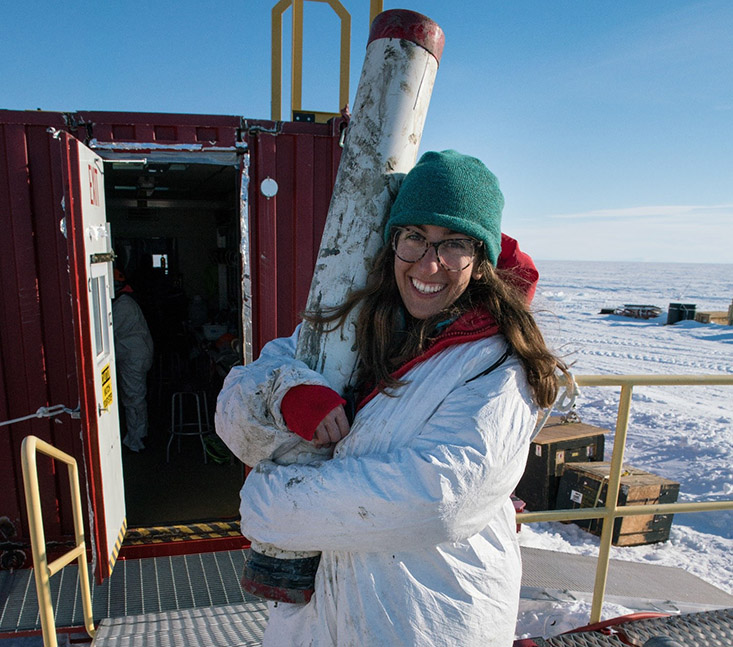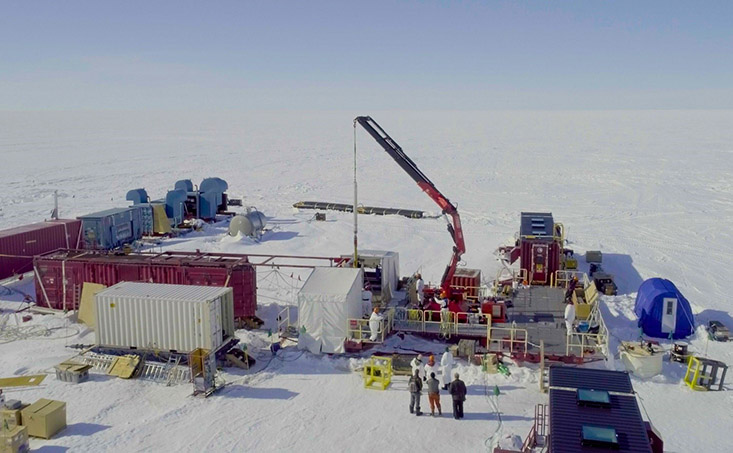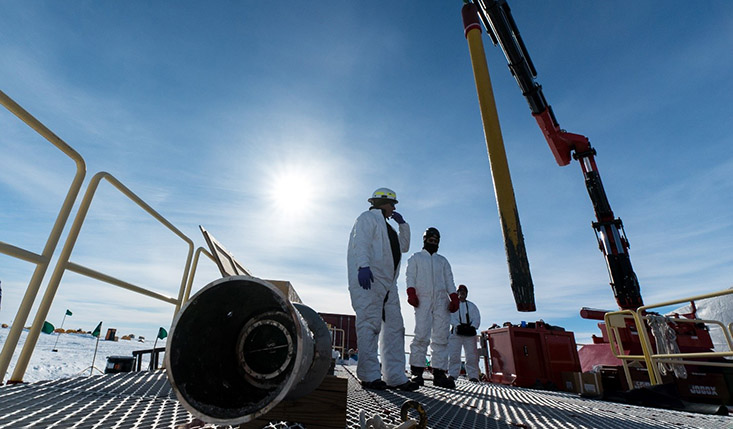Written by Sean Beckwith, PhD student
ST. PETERSBURG, FL – Receiving a cherished, albeit slightly belated Christmas gift, scientists from the USF College of Marine Science (USF CMS) hauled up their first sediment cores on December 31st, 2018, from the bottom of Lake Mercer, a subglacial lake buried more than a kilometer below ice in the middle of Antarctica.
This singular act of retrieving the core checked a lot of boxes on the polar research to-do list.
At 15 meters deep, Mercer is the deepest subglacial lake to have been directly sampled, building on the accomplishments of the WISSARD expedition to Lake Whillans, a subglacial lake downstream of Mercer with an average depth of about 2 meters at the time of sampling. Another success of the Subglacial Lake Mercer expedition, known as Subglacial Antarctic Lakes Scientific Access (SALSA), was the recovery of deeper sediment cores that extended down beyond the upper most sediments of the lake bed. The longer cores are the result of a collaboration between scientists from USF CMS and Woods Hole Oceanographic Institution that created a gravity corer capable of capturing as much as 5 meters of sediment.
The cores retrieved on the SALSA project were also the furthest south of any that have ever been extracted, just 600 km from the South Pole, where conditions are, to say the least, unforgiving.
For Dr. Brad Rosenheim, Associate Professor of Geological Oceanography at USF CMS, Ph.D. student Ryan Venturelli, and other team members, the first “result” of the expedition came well ahead of any data analysis. It was simply the success of their coring techniques. Immediately upon retrieval of the first sediment core, the team knew that they had developed a worthwhile method and created infrastructure that could be replicated for future missions to these remote environments.
“It was a treasure we just brought up to the surface,” said Rosenheim. “Not only for us but for the whole [scientific] community.”

Ryan Venturelli, USFCMS Ph.D. student, holds the first ever gravity core from a subglacial lake. Photo Credit: Billy Collins, SALSA
This early result came with high expectations but no promises. Other teams have been
thwarted with setbacks in their efforts to access subglacial lakes, and with all of
the first-time scenarios in the Mercer expedition, scientific success was anything
but guaranteed.
Although working in the realm of the unknown, portions of the drill project necessarily lived by the motto: “Failure is not an option.”
Only one custom gravity coring device was created for the expedition. Losing it down the borehole or allowing the hole to freeze up around it was a definitive no-go. A lost gravity-corer would corrupt the pristine subglacial lake (breaking Antarctic international treaties), and a corer frozen into the surrounding ice would render the borehole useless for the rest of the scientific team trying to send down tethered rovers or water chemistry sensors.
Despite balmy austral summer temps hovering just at or around 0°C at the surface, the temperature inside the borehole was around -30°C (-22°F). Freshwater from Lake Mercer clung to the rope used to lower and raise the coring device and froze into chunks of ice that presented some methodological nightmares for the team as the frozen rope hindered operation of the pulley system back up on the drilling platform. Scientists and crew came up with some novel ways to heat or otherwise free the rope of ice, and operations continued…although, at the expense of a bit more elbow grease than they had first expected.
The 1500-pound torpedo-like gravity corer passed cleanly through the perfectly vertical borehole and was dropped from a short freefall through the lake water and into the sediment. One of the attempts produced a core that measured 170 centimeters, which is the longest core recovered from a subglacial lake to date.
A cylindrical cage filled with sensors was also dropped through the kilometer long ice borehole to measure the lake water directly. Paired with water samples capped in situ for subsequent analysis in the laboratory, water measurements allow scientists to characterize the environment of living organisms. Rosenheim uses the water samples to measure various forms of carbon.
“It is important to figure out how carbon is sourced, budgeted, and consumed in this unique environment,” Rosenheim said, alluding to the discovery of microscopic organisms in a second Antarctic subglacial lake and to the question of how life survives beneath a kilometer of ice.
Another big question for Rosenheim concerns what the sediments can tell us about past climate responses; specifically, how did ice sheets respond to rapid warming in the recent geological past?
Venturelli, who first visited Antarctica on a preliminary trip to prepare the lab for the SALSA field season, has been tackling this question alongside Rosenheim as part of her Ph.D. dissertation work. As a continuation of their previous research, Venturelli and Rosenheim aim to use the Lake Mercer sediments to shed more light on the history of the West Antarctic Ice Sheet, which can teach us something about the possible consequences of our warming planet.
A technique developed by Rosenheim known as Ramped PyrOx (pyrolysis-oxidation) uses heat (up to 1000°C) to separate sediments by age. This capability is especially useful for analyzing subglacial lake sediments, which are difficult to date by traditional radiocarbon methods. Sediment in these unique bodies of water falls from overlying glaciers as they bulldoze their way across the lake surface, leaving scientists with a jumbled collection of sediment from mixed time periods, as opposed to the uniform layers laid down in linear fashion at the bottom of most lakes or deep ocean basins.

An aerial view of the gravity corer being retrieved. Photo credit: Billy Collins, SALSA
Subglacial lake sediments have only been sampled one other time before Lake Mercer,
and that was from Lake Whillans during the WISSARD expedition. This is a new frontier
and there are still a lot of questions. Scientists wonder how much sediment is transported
by lake water versus glacier, whether sediment leaves the lakes as they fill and drain
periodically, and, perhaps most importantly, whether an influx of marine water could
have filled the lake (bringing marine sediment along for the ride).
Lake Mercer actually lies below sea level, and an intrusion of marine water would suggest that ice sheets, at some time in the past, had destabilized enough to allow the seawater to reach the current location of subglacial Lake Mercer. By dating the sediments using Ramped PyrOx, Rosenheim and Venturelli can speak to the variability and magnitude of climate changes in the past.
A mission of the Rosenheim lab, in parallel to his scientific work, is to communicate the implications of polar research to people around the world. One community that should pay particular attention to his message lies just beyond the doors of his workplace in St. Petersburg, Florida. The greater Tampa Bay area has been deemed the second-most vulnerable metro in the U.S. to the financial impacts of climate change, largely due to the threat of rising seas and storm surge. With valuable data obtained from the Mercer expedition, Rosenheim, Venturelli, and other members of the SALSA team seek to understand just how much change in climate has triggered ice-sheet destabilization in the past and the timing and rate at which the melting occurred.
